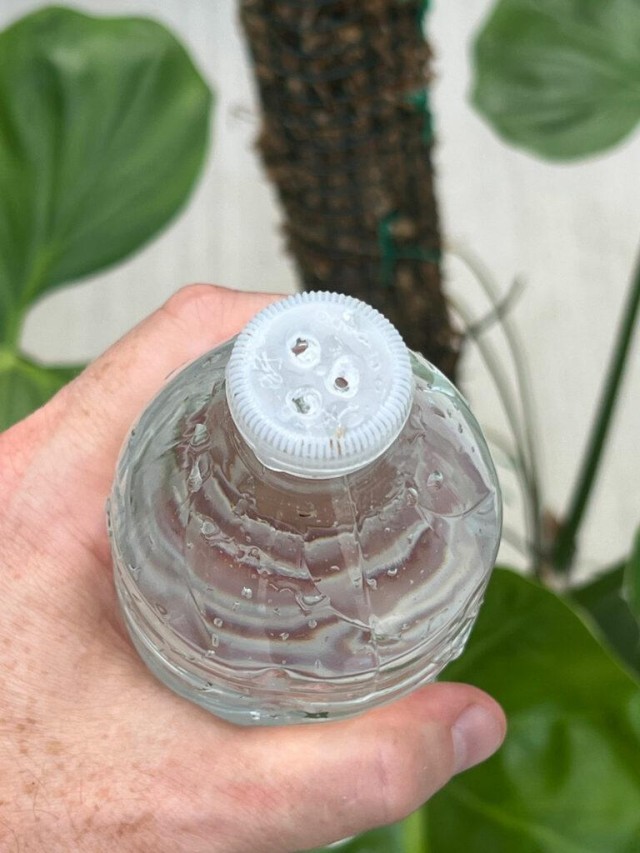Are you tired of constantly worrying about watering your moss pole and keeping it moist? Look no further! In this article, I will show you how to effortlessly create a self-watering moss pole using a simple technique. It may not be fully automatic, but it requires minimal effort and yields fantastic results. So, keep reading to find out more!
The Secret of a Self-Watering Moss Pole
The technique I’m about to share works wonders for DIY moss poles. Commercially available moss poles often fall short in quality, which is why I prefer to make my own. In fact, I have a detailed tutorial on how to create your own custom moss pole. Trust me, nothing beats the satisfaction of crafting one yourself!
Now, let’s dive into the steps for watering your homemade moss pole.
Step 1: Prepare a Water Bottle with Holes
To begin, gather a plastic water bottle and fill it with water. Then, carefully drill three small holes in the bottle’s lid. These holes allow water to slowly seep out and hydrate your moss pole. Feel free to experiment with different bottle sizes until you find the one that suits your needs best.

You may want to consider using a sturdier water bottle like Fiji, as they tend to be more durable.
Step 2: Create an Indentation on Top of the Moss Pole
Next, use your finger to create a small indentation at the top of the moss pole. This indentation will serve as a stable platform for the water bottle, preventing it from toppling over during the watering process.
Step 3: Insert the Upside Down Water Bottle
Now, simply insert the water bottle upside down into the moss pole, making sure the cap fits snugly into the indentation you created earlier. As you lower the bottle, you may notice air bubbles rising to the surface, indicating proper water flow. If you don’t see any air bubbles or the water level doesn’t decrease, adjust the holes by slightly enlarging them.

Here’s a moss pole example with a Philodendron giganteum.
After a few minutes, the water bottle will have emptied completely into the moss pole. The duration may vary depending on the hole size and bottle capacity. To ensure even moisture distribution, check the entire moss pole, paying special attention to the base. If it feels dry, refill the water bottle and repeat the process. Your moss pole will thank you!

This is my Philodendron giganteum in the greenhouse. Leave the water bottle in place or remove it until the next watering session.
The beauty of this water bottle method lies in its convenience and efficiency. No need to move your plant to the shower or sink anymore, which can be cumbersome and wasteful. Moreover, as your plant grows larger, it becomes increasingly impractical. With this technique, you save both time and water while keeping your beloved plants happy and hydrated.
Frequently Asked Questions
How often should I water my moss pole?
Ideally, you should never let your moss pole completely dry out. While it won’t harm your plants if it does happen, rewetting dried sphagnum moss can be time-consuming. Therefore, as soon as the moss feels slightly dry to the touch, go ahead and water it using the self-watering method explained above. Remember, drying times vary depending on factors such as temperature, humidity, and light.
Do I need to water the pot as well as the moss pole?
Opinions on this matter may differ, but here’s my take on it:
-
If you’ve recently installed a moss pole, you should water the pot as well. Until your plant establishes itself and develops roots in the sphagnum moss, watering the pot is necessary.
-
Some argue that the excess water from the moss pole will seep into the pot, eliminating the need for separate watering. However, I recommend checking the potting mix. If it remains dry after watering the moss pole, go ahead and water the plant.
-
For well-established plants that have successfully climbed the moss pole, you can allow the potting mix to dry out while keeping the moss pole consistently moist. Nonetheless, I still suggest watering the potting mix once it becomes completely or almost dry.
Why use a moss pole in the first place?
While not obligatory, a moss pole offers numerous advantages when growing climbing and vining plants. Here are a few of them:
-
It emulates the natural conditions these plants encounter in the wild, providing support and moisture.
-
Many plants, especially aroids like vining Monsteras, Philodendrons, and Pothos, will grow roots into the moss. Over time, this encourages the plant to produce mature foliage, resulting in larger leaves and potentially unique features like fenestrations.
-
Using a moss pole enables vertical growth, optimizing space and creating a visually pleasing display.
I hope you found this article helpful and inspiring. Don’t hesitate to share your experiences and thoughts in the comments below. Happy gardening!


